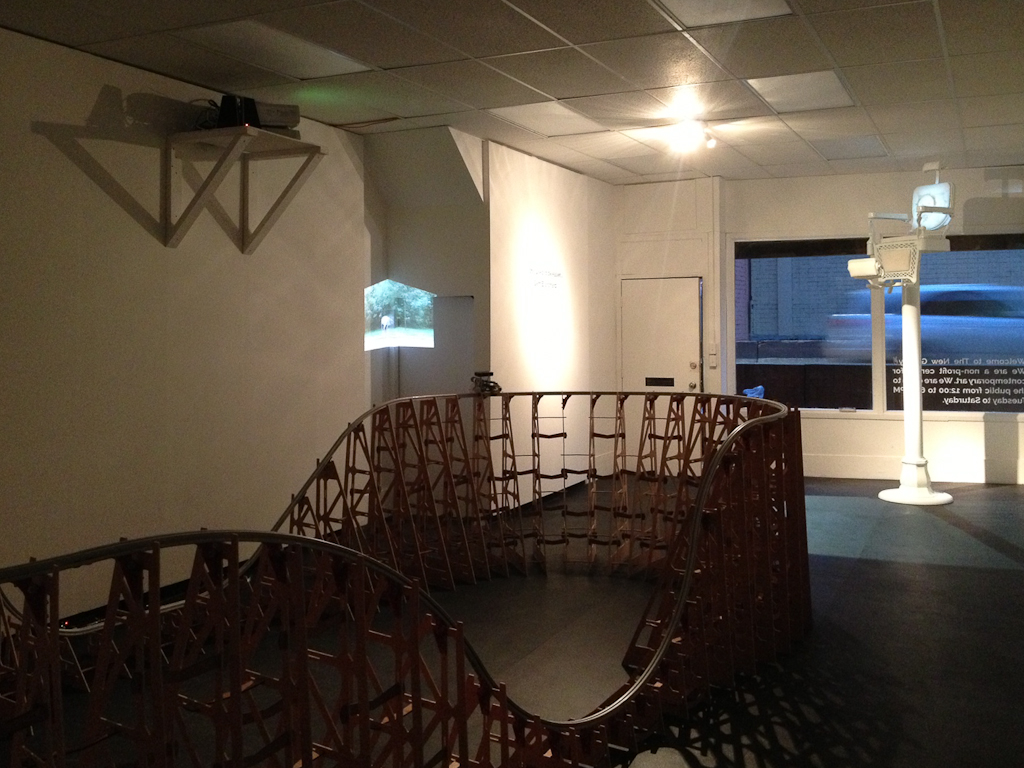MAINSPACE EXHIBITION /

…this used to be easier…
Sam Blanchard
September 6 to October 5, 2013
Sam Blanchard examines the trials and tribulations that constitute a day in the life of the “everyman”. He explores what and why it is to be excluded or included, comfortable or awkward, in or out of fashion. The rituals of the midwestern suburban middle management such as the morning jog, doing paperwork, or getting a haircut provide points of departure.
Essay
The most apt term to describe the work of Sam Blanchard is “inviting”. Dishearteningly, of late, the term is often utilized in a manner that connotes a notion of clichéd, derivative, and watered-down modes of creation; that are sold as aloof enlightenment. And sadly, this contemporary reading is the farthest thing from which these works should be aligned. This used to be easier and …a little off the top… epitomize the definition of “inviting” by subscribing to the notion that the artist possesses an awareness of the audience. Through this acknowledgement, an artist is capable of creating stories and entities that are decidedly more relevant, meaningful, and poignant than their more “inviting” brethren. This ability to entice a viewer into a work necessitates an awareness of common visual currency and the forethought to spend it wisely.
We see, within these works, the contorted forms of a youthful vacation’s wooden roller coaster, a now-defunct neighborhood barber’s chair, a private act of grooming, and a doctor’s demand for a patient’s daily exercise. We see a real love of making and an honorific attitude to creating entities with care and precision. These remembrances and creations of the artist possess a beautiful balance. They both have a history from which they are pulled and a future into which they will head, and balance on the delicate point of the here and now.
It is this friction driven balance that is showcased in a fun little machine that epitomizes the drudgery of obligatory exercise. One perceives a laughable expression crossing the face, only to realize it staves off the worry that one is not in control of the actions taking place. This balance also manifests itself in the realization that the lengthy planning and detailed mindset necessitated to create the scale version of an object is proportionately larger than what would be required for it’s life-size counterpart. The tension between humor and despair and the friction existent in youthful fantasies and adult realities points to a warning that self-reflection may turn to narcissism if left unchecked and without outside perspective. It is through these polarities that the works raise questions regarding all those who have ventured to these culturally familiar locals and not garnered those same experiences.
These works tap into those memories of slights, real and imagined. They spell out the vexations we take from childhood into early adulthood. They speak to the histories from which we have learned the most, but would wish our children to avoid. They tap into an instance that one physically and emotionally experiences, but where one lacks the benefit of language or a frame of reference the to digest the scenario. They invite a focused viewing of the less-than-honorable job known as daily living, while also showcasing the humor and empathy needed to succeed in that undertaking.
– Bob Marsh
Biographies
Currently residing in Blacksburg, VA, Sam Blanchard is an Assistant Professor of Sculpture at Virginia Polytechnic Institute and State University (Virginia Tech). He holds a MFA from the Rhode Island School of Design and a BFA from Ohio University.
Bob Marsh is an artist and educator residing in Grand Rapids, Michigan. He received his MFA from San Diego State University in 2005 and is currently the Chair of the Sculpture and Functional Art Program at Kendall College of Art and Design.






